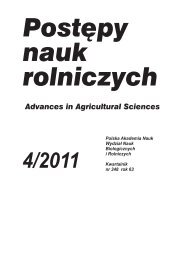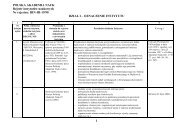Postepy nauk rolniczych - Instytucja Naukowa - Polska Akademia ...
Postepy nauk rolniczych - Instytucja Naukowa - Polska Akademia ...
Postepy nauk rolniczych - Instytucja Naukowa - Polska Akademia ...
Create successful ePaper yourself
Turn your PDF publications into a flip-book with our unique Google optimized e-Paper software.
18 A. Dobrzañski<br />
[57] Riemens M.M., Scheepens P.C., van der Weide R.Y. 2004. Dormancy, germination and emergence of weed<br />
seeds, with emphasis on the influence of light. Results of a literature survey. Plant Research International<br />
Wageningen B.V. Note 302.<br />
[58] Roberts H.A. 1982. Weed control handbook: principles. 7th edition BCPC. Blackwell Scientific Publications.<br />
Oxford: 533 ss.<br />
[59] Sanyal D., Bhowmik P.C., Anderson R.L., Shresta A. 2008. Revisiting the perspective and progress of<br />
integrated weed management. Weed Science 56: 161–167.<br />
[60] Scopel A.L., Ballare C.L., Radosevich S.R. 1994. Photostimulation of seed germination during soil tillage. New<br />
Phytologist 126: 145–152.<br />
[61] Taylorson R.B. 1982. Interaction of phytochrom and other factors in seed germination. W: The physiology and<br />
biochemistry of seed development, dormancy and germination. Elsevier Biomedical Press: 323–345.<br />
[62] Tester M., Morris C. 1987. The penetration of light through soil. Pl. Cell Environ. 10: 281–286.<br />
[63] Vincent E.M, Roberts E.H. 1977. The interaction of light, nitrate and alternating temperature in promoting of<br />
germination of dormant seeds of common weed species. Seed Science and Technology 5: 659–670.<br />
[64] Vleeshouvers L.M. 1997. Modeling weeds emergence patterns. Ph.D. Dissertation, Department of Theoretical<br />
Ecology. Wageningen Agricultural University, the Netherlands:165 ss.<br />
[65] Weso³owski M., Cierpia³a R. 2007. Wykorzystanie zjawiska fotoblastyzmu w regulacji zachwaszczenia<br />
pszenicy jarej. Prog. Plant Protection / Post. Ochr. Roœlin 47(3) : 296–299.<br />
[66] Wesson G.P., Wareing F. 1969. The role of light in the germination of naturally occurring populations of buried<br />
weed seeds. Journal of Experimental Botany 2: 402–413.<br />
[67] Wilson R.G. 1988. Biology of weed seeds in the soil. W: Weed Management in Agroecosystems: Ecological<br />
Approaches M.A. Aliteri, M. Liebman (red.). Boca Raton, FL CRC Press: 25–39.<br />
[68] Zoschke A., Quadranti M. 2002. Integrated weed management: quo vadis Weed Biology and Management 2:<br />
1–10.<br />
Segetal weed seeds response<br />
to night – time soil tillage<br />
Summary<br />
Key words: weeds, seeds, night-time tillage, weed control<br />
The aim of this paper was to refer the literature review on weed infestation and<br />
changes in segetal weed communities dependent on night-time and day-time soil tillage.<br />
Theoretical and practical aspects of breaking weed seeds dormancy in relation to<br />
light are discussed. According to seeds response to light, there are divided into three<br />
groups:- photoblastic positive (germinating in light, but not germinating in darkness),<br />
- photoblastic negative (giving opposite response), - indifferent (germinating both in<br />
light and darkness). The light stimulus is mediated by a photoreceptor in plants known<br />
as phytochrome. A lot of weed species develop a light-dependent stimulus for germination.<br />
Germination of light sensitive seeds can be reduced by exclusion of light. The<br />
exploitation of this knowledge for practical weed management led to the concept of<br />
soil cultivation in darkness as a potential way to reduce weed infestation. Following

















